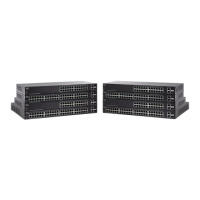IP Configuration
IP Addressing
Cisco 220 Series Smart Switches Administration Guide Release 1.1.0.x 180
15
If the switch does not receive a DHCPv4 response in 60 seconds, it continues to
send DHCPDISCOVER queries, and adopts the default IPv4 address:
192.168.1.254/24.
IP address collisions occur when the same IP address is used in the same IP
subnet by more than one device. Address collisions require administrative actions
on the DHCP server and/or the devices that collide with the switch.
When a VLAN is configured to use dynamic IPv4 addresses, the switch issues
DHCPv4 requests until it is assigned an IPv4 address from a DHCPv4 server. Only
the management VLAN can be configured with a static or dynamic IP address.
The IP address assignment rules for the switch are as follows:
• Unless the switch is configured with a static IP address, it issues DHCPv4
requests until a response is received from the DHCP server.
• The System LED on the front panel of the switch changes to solid green
when a new unique IP address is received from the DHCP server. If a static
IP address has been set, the System LED also changes to solid green. The
System LED flashes when the switch is acquiring an IP address and is
currently using the factory default IP address 192.168.1.254.
• The same rules apply when a client must renew the lease, prior to its
expiration date, through a DHCPREQUEST message.
• With the factory default settings, when no statically-defined or DHCP-
acquired IP address is available, the default IP address is used. When the
other IP addresses become available, the addresses are automatically
used. The default IP address is always on the management VLAN.
To access and manage the switch by using the web-based interface, the switch
management IP address must be defined and known. The default configuration of
the switch is to use its factory default IP address of 192.168.1.254. The switch IP
address can be manually configured.

